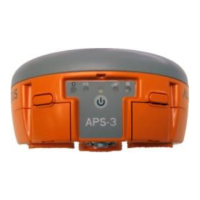6.3. Question: I noticed that the units get hot at the top. What effect might this
have on any operations?
Answer: The APS-3 is designed to operate reliably from -20 to +65 °C. Like
most manufacturers, we test beyond that limit to ensure we can operate at
the published extremes.
6.4. Question: Why am I not receiving GLONASS corrections?
Answer: First confirm that the base station transmits GLONASS corrections.
The APS-3 utilizes GPS satellites to get to RTK Fixed status first. Then if more
than 2 acceptable GLONASS satellites are available, GLONASS is added to the
solution for Fixed GPS+GLO RTK.
6.5. Question: Why is my radio not receiving RTK corrections?
Answer: First check Base Station Configuration. Make sure that Base Station
receiver is set up and using more than 5 common Satellites. Check Rover
Configuration; make sure that it is configured to use the same RTK format
corrections as the base. Both Base Station and Rover must use the same UHF
Radio Channel and same radio settings. Moving the base and rover further
apart (or lowering base transmit power) may help to establish a connection
between the radios more quickly.
6.6. Question: How do I know which message type to select RTCM V2.3, RTCM
V3.0, CMR, or CMR+?
Answer: Base stations are capable of transmitting different messages types.
It is important to confirm the base and Rover are set to the same message
type. If you are able to set both base and rover, then use RTCM3.x as this
format is compatible with virtually all receivers.
6.7. Question: My receiver will not respond to commands, why not?
Answer: A setting in the APS-3 has changed causing a disruption with power
communication. Power the unit off, remove all power sources for 15 seconds,
and turn the unit back on. After the unit boots, perform a hard reset and
upload the default script to restore settings.
If you are using a USB-Serial adapter, the adapter may not be compatible
with the APS-3. If possible connect directly to a physical COM port on the PC.
Otherwise, adapters using Prolific drivers have been found to work more
reliably.

